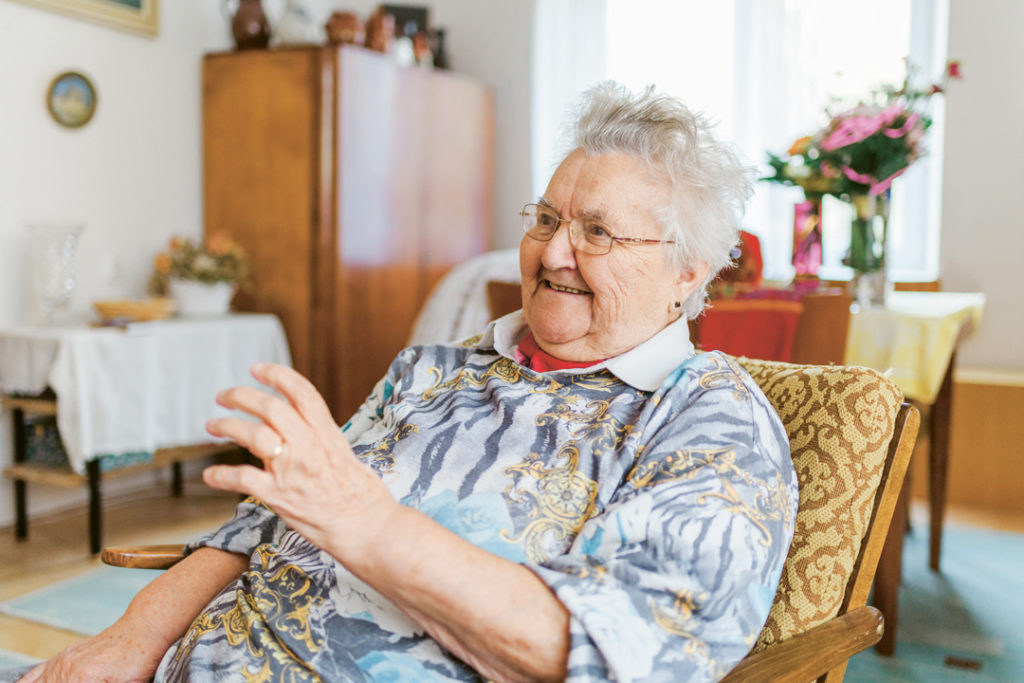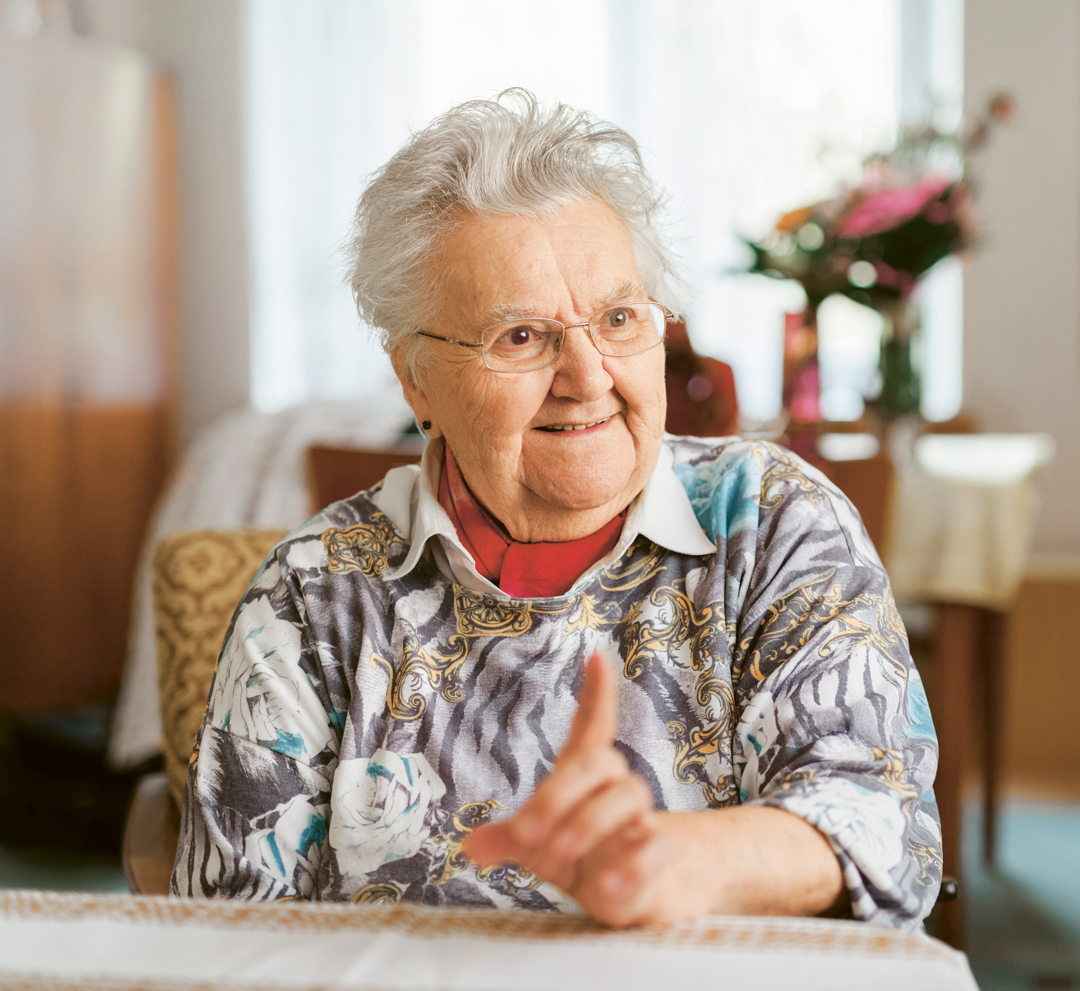When she describes folk customs, her narrative is so joyful and colourful that you can easily imagine a lovely village in the Haná region. When she recalls the traditional festive dishes, which probably wouldn’t attract today’s gourmets, you get the feeling these delicacies are worth a Michelin star. And when she starts to speak about people enjoying Advent and Christmas time in a village, you realize how we celebrate Christmas in such materialistic and consumerist way. This is so shallow and empty. Marie Pachtová is such admirable woman with an excellent memory, stunning zest for life, and a lifelong love for folk culture. This love is visible in her forty-eight-year career of teaching and choreographing child folk group Klebetníček in Vyškov.
One of the performances of the Klebetníček group is focused mainly on Christmastime and represents all essential Christmas moments from Advent Sunday to the Three Wise Men. ‘Advent used to be a calm time in a month but it wasn’t sad at all. On the contrary, it was the time full of special events which were followed and honoured here in Haná,’ says Marie Pachtová. ‘Christmastime used to bring plenty of joy for children and adults. During long evenings at home, people used to read, chat, and sing together. Children played in the snow, got tired and were happy to hear a good storytelling or a song after. Sadly, these activities are almost forgotten these days,’ she adds.
DAD USED TO WRESTLE WITH A DEVIL FOR SAINT NICHOLAS’ PRESENTS
Advent begins on the first Advent Sunday and there is Saint Barbara’s Day on December 4 which makes the start of the church year a little bit magical and superstitious. ‘According to a tradition, girls pick small branches of cherry tree, apple tree, or golden rain. If they bloom on Christmas Eve, they will get married next year,’ Marie explains the characteristics of the holiday.
After Saint Barbara’s Day, here comes Saint Nicholas who is associated with presents for children. ‘It wasn’t any different during my childhood. Saint Nicholas was in his garnet with a hat and a pole. He was accompanied with an angel and a devil. But sometimes the devil wasn’t allowed to come in a house. Our grandmother used to be very strict and sometimes happened that the devils wanted to repay her behaviour. So she didn’t let the devils in,’ the former teacher remembers her childhood in Dědice.
She has Saint Nicholas’ Day associated with her dad forever. ‘He worked in a brewery in Vyškov and day before St. Nicholas’ Day he always brought us some gingerbread. He always used to say: You didn’t listen at home, you didn’t help at home, but I met Saint Nicholas, an angel and a devil. I beg them but they refused to give me presents for you. However, they told me if I can beat the devil they would give me some presents. So I fought and defeated the devil and I got presents for you. As children, we were so frightened when we imagined our father fighting the devil,’ she laughs.
It was obvious which children were rich and which weren’t. ‘The next day, when we went from school, we always checked what everyone else got. These present were usually shown behind the windows so everyone could see them. Wealthy families had dolls, horses, or hussars and the others had apples, nuts, dried fruit, or a gingerbread toy,’ says Marie about presents which probably wouldn’t be attractive enough for today’s children.
IT WAS SO SCARY WHEN LUCA KNOCKED ON THE WINDOW
One holiday after another and week after St. Nicholas’ Day there is St. Lucia’s Day on December 13. ‘This is a very important holiday. As weather lore predicts: Saint Lucia shortens night but doesn’t extends day. It basically means that day is as long as night. Since this day, nights are shortened and we get more sunlight,’ she mentions an importance of the holiday.
On this particular day, girls used to dress up in white cloaks with faces painted white with flour and they visited every house in the village. They were called the Luca girls. ‘St. Lucia is a patron of seamstresses and she didn’t want to women to work on this day. The Luca girls used to check if every household is tidy and clean. When they saw dirt or dust, they would overturn everything and stain it with flour or ashes,’ she amusingly recalls the custom which is still maintained in the Nordic countries.
Even on this holiday you can see how Christmastime used to be entertaining. ‘These women certainly had sense of humour and they just wanted to tease neighbours. It was always spooky when these Luca girls knocked on the window and children were frightened when they saw all those scary masks. It was another gift which enriched life of villagers. However, this holiday was rare even during my childhood,’ adds the florist.
TORN CAKES AND COOKED DRIED FRUIT? SUCH A DELICACY!
Everything was slowly heading toward Christmas Eve. We all expect presents and Christmas sweets. But how people used to celebrate Christmas during Marie Pachtová’s childhood? ‘As not so wealthy family, we used to have torn cakes on Christmas dinner and it was such a delicacy,’ says Marie with a spark in her eyes. ‘They were such huge cakes without stuffing and baked with a lot of butter. As they were pulled out of an oven, they were immediately torn into pieces, sprinkled with poppy seeds with sugar, and then dripped with honey. Because they were so warm, everything sweet stuck to them and we layered them. Let me tell you, it was such a delicious sweet meal,’ Marie describes the Christmas menu.

The other dishes we used to eat on Christmas Eve were a thick soup made of proso millet and a sweet sauce. ‘It was a butter fried sauce made of plums, raisins and cinnamon. It smelled so good! We used to eat the sauce together with the pieces of the torn cake. My grandmother always told me that raisins would bring us luck and health,’ she says. At the end of the meal, we had a hot beverage made of dried fruit. We cooked separately cherries, apples and pears. ‘When everything was cooked, we added sugar and poured everything into a big bowl. Well, it was such a great pleasure to drink something like that after the good dinner,’ gushes Marie.
We didn’t get presents like we get nowadays. ‘Everyone who sat at the table got about five nuts and a small apple. These were our presents,’ she explains. Nowadays’ customs aren’t any different as the old ones. We used to cut an apple, to crack nuts to see if we would be healthy next year and we used to send egg shells over the water or we throw a shoe.
THE DECLINE OF CUSTOM WAS CAUSED BY WAR AND THE YEAR 1948
After dinner, we celebrated the nativity of Jesus. ‘We were always looking forward to see a Bethlehem in a church. We always looked at all these small doll figures and tried to recognize our neighbours,’ she reminds us other attributes of traditional Christmas. Christmas day wasn’t any special but the day after, there was Saint Stephen’s Day: ‘On this day we went to see our neighbours and friends.’ New Year’s Eve wasn’t celebrated like we do it nowadays. ‘In the morning after worship, neighbours wished themselves only the best and shook hands.’
They whole period culminated on Three Kings’ Day. ‘These poor boys from the Drahan Highlands used to go door to door to sing and get some financial donations. After this event, the Slavic carnival begun but that’s a different chapter of folk customs,’ Marie says.
Many of Christmas traditions were forgotten and World War II played a huge part in it. During the war, all public events were banned. Then the Communist regime came. ‘The Communism didn’t prefer any traditional customs associated with religion so everything was in decay. The ethnographic groups began to emerge in 1960s and they helped to maintain some tradition without religious connection. The traditions were alive, at least,’ admits the woman who at age 86 still leads the folk group Klebetníček. This is where she ensures her successor. ‘I’m very happy about it. They’re so talented. The Haná region has a huge wealth but it needs to be handled carefully and pass it on to younger generation. Because as soon as we stop to pass our traditions on, it will be over,’ warns Marie Pachtová.



